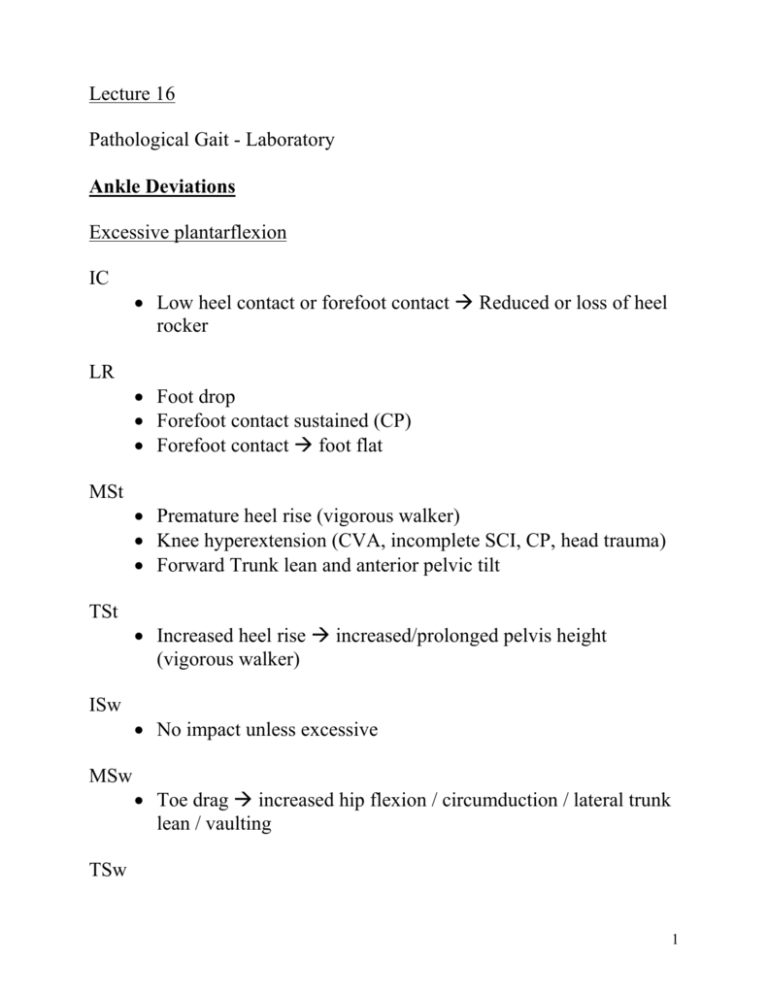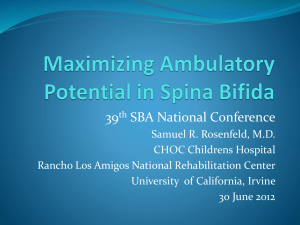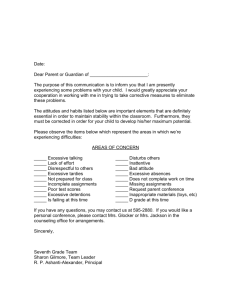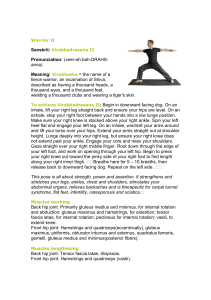Lecture 16-PathoGait
advertisement

Lecture 16 Pathological Gait - Laboratory Ankle Deviations Excessive plantarflexion IC LR MSt Low heel contact or forefoot contact Reduced or loss of heel rocker Foot drop Forefoot contact sustained (CP) Forefoot contact foot flat Premature heel rise (vigorous walker) Knee hyperextension (CVA, incomplete SCI, CP, head trauma) Forward Trunk lean and anterior pelvic tilt TSt Increased heel rise increased/prolonged pelvis height (vigorous walker) ISw No impact unless excessive MSw Toe drag increased hip flexion / circumduction / lateral trunk lean / vaulting TSw 1 Usually no impact unless coupled with inadequate knee extension Causes: 1. Weakness of pretibial muscles 2. Plantarflexion contracture 3. Soleus/gastroc spasticity 4. Secondary to quadriceps weakness to protect from knee hyperextension by reducing the heel rocker Excessive Dorsiflexion IC Rare exaggerated heel rocker LR Increased heel rocker accelerated tibial advancement increased knee flexion MSt TSt Accelerated tibial advancement and/or excessive dorsiflexion greater demand on quadriceps to control knee flexion Prolonged heel contact Excessive knee flexion PSw Loss of plantarflexion Sustained heel contact Swing - Does not usually cause a problem Causes: 1. Triceps surae weakness 2 2. Ankle locked at neutral secondary to fusion or orthosis Foot/Ankle Dysfunctions Equinovarus Secondary to plantarflexor (soleus, TP, FHL, FDL)over activity Either premature or prolonged Valgus / Planovalgus Secondary to total inverter weakness (flaccid or spastic) as opposed to peroneal overactivity Can be coupled with the collapse of the arch (ligamentous laxity) 3 Knee Deviations Inadequate flexion LR Limited is usually secondary to knee joint pathology Absent knee flexion desirable with extreme quad weakness to provide for stability Reduced shock absorption PSw Ankle excessively dorsiflexed Heel contact prolonged ISw MSw Toe drag Decreased ability to advance the limb Toe drag Can occur with lack of hip flexion Excessive Extension (during stance only) Extension thrust Excessive extensor force when knee lacks hyperextension range Accompanied by premature ankle plantarflexion and decreased hip flexion Hyperextension (recurvatum) Slow/passive or active/abrupt Can be secondary to strong hip extensor or soleus contraction 4 Causes of Inadequate Knee Flexion / Excessive Knee Extension: 1. Quadriceps weakness stance 2. Pain stance and swing 3. Quadriceps spasticity stance and swing 4. Exessive ankle plantarflexion stance 5. Hip flexor weakness swing 6. Extension contractures capsular scarring or quadriceps contracture – (need 60 deg of flexion) Excessive Knee Flexion LR Knee flexion > 25 degrees Excessive dorsiflexion MSw Usually secondary to excessive hip flexion Not clinical concern Inadequate Knee Extension MSt and TSt Usually a continuation of excessive flexion during LR TSw Limb not fully prepared for IC 5 Causes: 1. Inappropriate hamstring activity swing and stance Spasticity Voluntary secondary to glute max insufficiency Prolonged or premature 2. Knee flexion contracture swing and stance 30 deg secondary to joint swelling 3. Triceps surae weakness stance during MSt and TSt and is often associated with excessive dorsiflexion and sustained heel contact 4. excessive plantarflexion - swing to avoid toe drag associated with excessive hip flexion Coronal Gait Deviations in the Knee Varus (adduction) Valgus (abduction) Causes: Static - structural deformities 1. congenital or development deformities 2. traumatic deformities Dynamic – secondary to disease process 1. OA – varus (medial tibial plateau) 2. RA - valgus 3. Paralytic Gait glute med weakness lateral trunk lean valgus 6 Hip Deviations Inadequate Extension MSt TSt Forward trunk lean Lumbar lordosis – least stressful of 3 methods Flexed knee Lumbar lordosis via anterior pelvic tilt loss of trailing limb decreased step length (contralateral limb) Excessive flexion PSw and ISw Usually a continuation of inadequate extension Rapid advancement of limb secondary to release of flexors under tension swing initiated prematurely MSw Often reflected by posterior pelvic tilt Common substitution for excessive plantarflexion Causes: 1. 2. 3. 4. Hip Flexion contracture Anterior ITB contracture Hip Flexor spasticity Pain – intra-articular pressures least at 30-40 deg of flexion 5. Arthodesis –surgical or spontaneous 6. Voluntary flexion secondary to excessively plantarflexed foot 7 Inadequate Hip Flexion ISw Failure to reach 15 deg flex reduces limb advancement MSw Continuation of ISw – little flexor action available TSw, IC, LR No additional flexion since MSw reduced step length Causes: 1. Hip flexor weakness 2. Joint arthrodesis (rare) Compensation for Hip Flexor Insufficiency: 1. posterior pelvic tilt with abdominals 2. circumduction hip hiking via quadratus lumborum forward pelvic rotation hip abduction 3. excessive/rapid knee flexion 4. contralateral vaulting 5. lateral lean to opposite side Excessive Coronal Plane Motion Excessive Adduction Stance excessive medial angle of thigh (coxa vera) resulting in knee valgus contralateral pelvis drop 8 Swing scissor gait *excessive adduction can be confused with excessive hip IR and flexion pseudo-Adduction Causes: 1. ipsilateral abductor weakness 2. ipsilateral adduction contracture or spasticity 3. substitution of adductors(longus, brevis, gracilis) as hip flexors (weak iliacus) 4. contralateral hip abduction contracture – tight lateral musculature scissor gait Excessive Abduction Stance – wider base of support – requires more energy Causes: 1. ipsilateral hip abduction contracture 2. ipsilateral short leg – only if severe 3. ipsilateral voluntary abduction – during circumduction (abduction, pelvic rotation, and hiking) 4. contralateral hip adduction contracture 5. scoliosis with pelvic obliquity Excessive Transverse Rotation (10 degrees 5/5) can be secondary to hip motion or pelvic/trunk motion Causes of excessive external rotation: 1. glute max overactivity 2. excessive plantarflexion (equinus) often during later stance 9 Causes of excessive internal rotation: 1. medial hamstring overactivity during swing 2. adductor overactivity 3. anterior abductor overactivity (TFL and anterior glute medius) 4. quadriceps weakness 10







